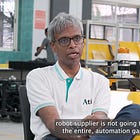Robots that borrow parts and heal, Xtend completes $70 million funding, and more
Daily brief on news from the world of autonomous mobile robots.
Xtend secures $30 million extension to complete $70 million Series B
XTEND has closed a $30 million extension to its $70 million Series B funding round, backed by Aliya Capital Partners and Protego Ventures. The funds will accelerate production of XTEND’s AI-powered tactical autonomous robotic systems and enable further U.S. and global expansion.
XTEND will also boost R&D into its XOS operating system, which merges human guidance with machine autonomy for defense, homeland security, and emergency response deployments worldwide.
Scientific Systems unveils VENOM, an autonomous naval interceptor USV
Scientific Systems has introduced VENOM, a nine-meter-long, multi-mission unmanned surface vehicle designed for the U.S. Navy’s operational needs. Featuring a robust HDPE hull and 300HP diesel engine, VENOM delivers speeds over 35 knots and a 500-nautical-mile range.
Its AI-driven autonomy enables obstacle avoidance, extended loitering, and high-speed interception, supporting missions from force protection to maritime logistics. VENOM is now available for Department of Defense procurement following successful sea trials.
Diligent Robotics’ Moxi robot surpasses 300,000 pharmacy deliveries
Diligent Robotics’ Moxi robot has reached a milestone of more than 300,000 pharmacy deliveries in U.S. hospitals, marking a significant achievement in healthcare automation.
Deployed nationwide, Moxi assists clinical staff by handling routine deliveries of medication and supplies, saving over 575,000 staff hours and reducing unnecessary walking. Its success demonstrates the transformative impact of mobile robots in healthcare, where Moxi supports better efficiency and patient care outcomes.
Shapeshifting modular robots can grow and repair by consuming one another
Columbia University researchers have developed modular robots capable of “robot metabolism” — physically growing, adapting, and healing by absorbing parts from their environment or other robots.
Using magnetic modules, these robots self-assemble into various structures, replace damaged components, and increase abilities—for example, adding new parts to move faster. This biologically inspired approach enables robots to autonomously adapt to new tasks or recover from damage, with applications envisioned for disaster recovery and space exploration.
SinceVision to showcase next-generation sensing systems at IAIE 2025 Qingdao
SinceVision, a leader in intelligent industrial sensors, will present its latest sensing solutions at the 27th Qingdao International Industrial Automation Technology & Equipment Exhibition (IAIE 2025) that’s started today and will conclude on July 20.
The company will highlight high-precision SCMOS and high-speed cameras, laser displacement sensors, and 3D laser profilers. Live demos will demonstrate enhanced inspection for applications such as appliance manufacturing, electronics, and woodworking.


